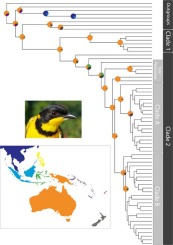Petter Z. Marki, Jon Fjeldså, Martin Irestedt, Knud A. Jønsson. Molecular phylogenetics and species limits in a cryptically coloured radiation of Australo-Papuan passerine birds (Pachycephalidae:
Colluricincla). Molecular Phylogenetics and Evolution, In Press, Accepted Manuscript, Available online 8 March 2018
Abstract:
Detailed knowledge of species limits is an essential component of the study of biodiversity. Although accurate species delimitation usually requires detailed knowledge of both genetic and phenotypic variation, such variation may be limited or unavailable for some groups. In this study, we reconstruct a molecular phylogeny for all currently recognized species and subspecies of Australasian shrikethrushes (Colluricincla), including the first sequences of the poorly known C. tenebrosa. Using a novel method for species delimitation, the multi-rate Poisson Tree Process (mPTP), in concordance with the phylogenetic data, we estimate species limits in this genetically diverse, but phenotypically subtly differentiated complex of birds. In line with previous studies, we find that one species, the little shrikethrush (C. megarhyncha) is characterized by deep divergences among populations. Delimitation results suggest that these clades represent distinct species and we consequently propose a new classification. Furthermore, our findings suggest that C. megarhyncha melanorhyncha of Biak Island does not belong in this genus, but is nested within the whistlers (Pachycephala) as sister to P. phaionota. This study represents a useful example of species delimitation when phenotypic variation is limited or poorly defined.
Proposed species-level taxonomy of
C. megarhyncha:
C. megarhyncha (
megarhyncha, batantae, parvula) - Arafura Shrikethrush
C. tappenbecki (
tappenbecki, madaraszi, maeandrina) - Sepik-Ramu Shrikethrush
C. rufogaster (
rufogaster, aelptes, gouldii, griseata, normani, synaptica) - Rufous Shrikethrush
C. discolor (monotypic) - Tagula Shrikethrush
C. obscura (
obscura, idenburgi) - Mamberamo Shrikethrush
C. affinis (monotypic) - Waigeo Shrikethrush
C. fortis (
fortis, despecta, neos, superflua) - Variable Shrikethrush







